Matisse® 2 Ultra-Narrow Linewidth Tunable Ring Lasers
Overview
Matisse® single frequency ultra-stable, narrow linewidth tunable ring lasers are ideal for Quantum and AMO (atomic, molecular and optical physics) applications. The Matisse 2 system has the industry’s highest output power, the narrowest external linewidth, the broadest tuning range, and the most flexible architecture. Coupled with the Millennia® eV™ 25 pump laser, It produces over 7.2 W of output power. With flexibility to be configured for either Ti:Sapphire or dye as the laser gain medium, Matisse 2 provides an unprecedented tuning of >470 nm and linewidths down to 30 kHz, with fully integrated PDH lock to X reference cell.
- Highest output power available >7.2 W
- Narrowest linewidth <30 kHz
- Widest mode-hop-free Piezo tuning of 50 GHz
- Dust-sealed housing and massive steel baseplate
Products
Applications
- High-resolution Spectroscopy
- Quantum Physics
- Atom cooling
- Magneto-optic trapping (MOT)
- Atomic clocks
- Bose-Einstein condensates
- Frequency combs
- Quantum computing
- Microcavity resonators
Specifications
General Characteristics1
| Matisse 2 TR | Matisse 2 TS | Matisse 2 TX-light | Matisse 2 TX | Matisse 2 DR | Matisse 2 DS | Matisse 2 DX | |
|---|---|---|---|---|---|---|---|
| Laser Gain Medium | Ti:Sapphire | Ti:Sapphire | Ti:Sapphire | Ti:Sapphire | Dye | Dye | Dye |
| Linewidth5 | <4 MHz rms | <50 kHz rms6 | <50 kHz rms6 | <30 kHz rms6 | <20 MHz rms6 | <200 kHz rms6 | <100 kHz rms6 |
| Beam Diameter2 | 1.4 mm (typical) | 1.4 mm (typical) | |||||
| Beam Divergence7 | <1 mrad | <1 mrad | |||||
| Amplitude Noise | <0.1% rms (above pump noise, added in quadrature) | <0.5% rms | |||||
| Scan Range | >50 GHz (at 780 nm) | >60 GHz (at 575 nm) | |||||
Tuning Range3,8
| Matisse 2 TR | Matisse 2 TS | Matisse 2 TX-light | Matisse 2 TX | Matisse 2 DR | Matisse 2 DS | Matisse 2 DX | |
|---|---|---|---|---|---|---|---|
| MOS-1 Optics Set | 680-790 nm | 680-790 nm | 680-790 nm | 690-770 nm | - | ||
| MOS-2 Optics Set | 750-870 nm | 750-870 nm | 750-870 nm | 750-870 nm | - | ||
| MOS-2-BB Optics Set | 730-930 nm | 730-930 nm | 730-930 nm | 730-930 nm | - | ||
| MOS-3 Optics Set | 880-1038 nm | 880-1038 nm | 880-1038 nm | 880-1010 nm | - | ||
| MOS-4 Optics Set | - | 550-660 nm | 550-660 nm | 550-660 nm | |||
| MOS-5 Optics Set | - | 650-760 nm | 650-760 nm | 650-760 nm | |||
Output Power4
| Matisse 2 TR | Matisse 2 TS | Matisse 2 TX-light | Matisse 2 TX | Matisse 2 DR | Matisse 2 DS | Matisse 2 DX | |
|---|---|---|---|---|---|---|---|
| Millennia eV 25 W pump | 7.2 W | 6.2 W | 6.0 W | 4.5 W | |||
| Millennia eV 20 W pump | 5.5 W | 4.7 W | 4.5 W | 3.4 W | |||
| Millennia eV 15 W pump | 3.8 W | 3.3 W | 3.0 W | 2.2 W | |||
| Millennia eV 10 W pump | 2.0 W | 1.6 W | 1.8 W | 1.4 W | |||
| Millennia eV 5 W pump | 0.8 W | N/A | 0.8 W | N/A | |||
Millennia Pump Laser and Lab Requirements
| Matisse 2 TR | Matisse 2 TS | Matisse 2 TX-light | Matisse 2 TX | Matisse 2 DR | Matisse 2 DS | Matisse 2 DX | |
|---|---|---|---|---|---|---|---|
| Pump Laser Polarization | Horizontal | ||||||
| Pump Laser Power | 5-25 W | ||||||
| Ambient Conditions | ±0.5°C in the 20-25°C range, non-condensing humidity conditions | ||||||
| Cooling | Water required to remove 20 W of heat from crystal; series connection from Millennia chiller recommended; 16-21°C ±0.1°C suggested Dye versions: Water required to remove 100 W from dye circulator |
||||||
| Laboratory | Vibrational isolated optical table, dust-free air (flow box) | ||||||
| Electrical | 100-250 VAC, max 2.5 A | ||||||
| Computer Control | Windows operating system | ||||||
Footnotes:
- Due to our continuous product improvement, all specifications are subject to change without notice.
- At Matisse 2 output port.
- Specification applies to Millennia eV 15 W, 20 W and 25 W pump lasers. Please inquire for other pump powers.
- At 780 nm for Ti:Sapphire and at the peak of R6G dye for dye version.
- Linewidth measurements made over a period of >100 msec.
- Linewidths relative to built-in reference cavity.
- Measured at half angle.
- Extended tuning ranges available upon request. Contact Spectra-Physics.
Features
Out of Plane Ring Resonator

The Out of Plane cavity design is a stable and more reliable configuration delivering years of worry free operation. All CW ring lasers support uni-directional propagation of light within the laser cavity. Most ring lasers utilize a thin intracavity waveplate which is easily damaged, resulting in lower output power and performance. The Matisse lasers are configured with an Out of Plane cavity design eliminating the need for this thin waveplate.
Narrowest Linewidth
The Matisse is available with three levels of frequency stabilization: Passive stabilization with phase lock loop, active stabilization with reference cell, and active stabilization with Pound-Drever-Hall locking for ultranarrow linewidths to <30 KHz (100 ms integration time).
Mode-Hop-Free Tuning
Superior mechanical stability, specially designed optical mounts, unique tuning methods, and the preferred Out of Plane cavity design of the Matisse C all contribute to the exceptional mode-hop-free scanning range of >50 GHz. In order to take this to the next level, we have developed “Scan Stitching” for wide mode-hop-free tuning over the full wavelength range (up to 300 nm).
Flexure Optical Mounts for Optimal Power Flatness
Even the smallest tilts in linear travel when wavelength tuning by changing the cavity length of a ring laser will result in decreased output power. All optics meant to travel linearly in the Matisse are mounted on flexure optical mounts. These mounts enlarge the scan range and guides linear translation, therefore providing power flatness to within 5% across 50 GHz of mode-hop-free tuning.
Pumped by Millennia® eV™ DPSS Laser
The Millennia eV platform is based on Spectra-Physics’ It’s in the Box™ design, where the laser optical cavity, diode and control electronics are all integrated in a single, compact package, eliminating the need for an external power supply. With its industry leading scalability from 5 W to 25 W average power and high reliability, Millennia eV is the next generation laser of choice for demanding scientific applications such as the pumping of CW Ti:Sapphire lasers.
Variable Low Frequency Locking
CW single frequency ring lasers utilize a Phase Lock Loop (PLL) in order to stabilize the laser cavity to a single longitudinal mode. The Matisse incorporates a unique PLL technique that delivers low dither frequencies (down to 500 Hz) to minimize laser noise and allows easy adjustability of the frequency (500 Hz – 3 kHz) via software.
Counter Drift Option
The Matisse can counteract the wavelength drift which is specific to any tunable CW single mode laser. To further counteract drift for a Matisse without reference cavity, a good wavemeter can be used as reference. Or for a Matisse laser with reference cavity an optional strain gauge can be installed on the scanning piezo. It is also possible to use the Matisse reference cavity as a transfer cavity or to stabilize it to an atomic resonance or a frequency comb.
Matisse Software Control
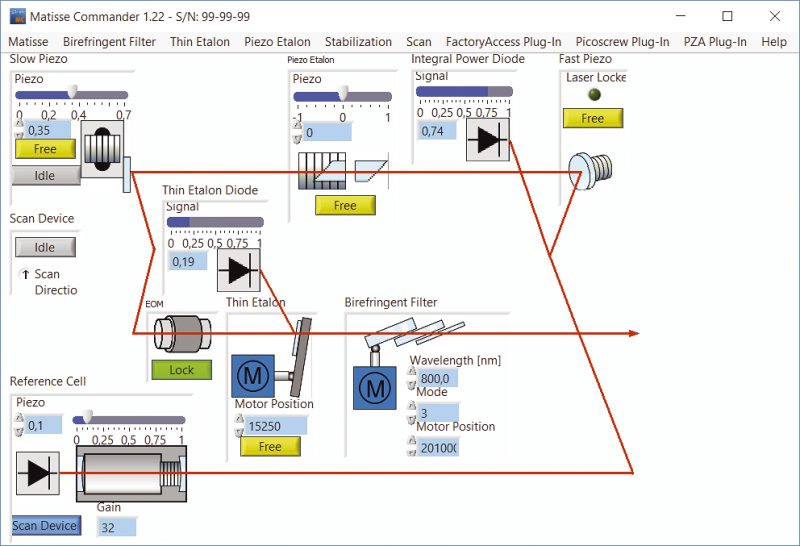
- Fully Automated Software Control: The Matisse is controlled with an intuitive GUI allowing fully automated and easy operation. Functionality, such as wavelength selection, piezo scanning, and frequency locking are easily visualized with a pictorial schematic of the Matisse laser cavity. Other GUI windows display automated monitoring of beam alignment and laser performance.
- Dynamic Scan Range: The Dynamic Scan Range function allows easy adjustment of the wavelength tuning resolution. This is achieved via a built in switchable piezo amplifier with easy software control. Tuning resolutions down to 50 kHz can be selected when fine wavelength adjustments are needed.
- Automated Scan Stitching: The Matisse can perform indefinitely long scans by stitching the 50 GHz scans together. An implemented software routine automatically optimizes the position of all the optical elements involved in wavelength selection, allowing to scan the laser in 50 GHz steps without the need to manually reset or realign any components.
Matisse 2 TR and DR
The Matisse 2 R-Series ring laser with its mechanically quiet design provides excellent passive stability and ultra-low noise, single-frequency operation. Electronically controlled wavelength-selecting elements—a birefringent filter, a thick etalon, and a thin etalon—keep the laser centered on a single longitudinal mode. This enables long, mode-hop-free wavelength scans while maintaining constant, low-noise output power levels.
The Matisse 2 TR Ti:Sapphire ring laser provides a spectral linewidth of <4 MHz and can be readily upgraded to the higher resolution Matisse 2 TS. In fact, because of its modularity, any Matisse 2 laser can be field upgraded to either a Ti:Sapphire or dye gain medium, or to a configuration with higher resolution – from an R-Series to an S-Series or an X-Series.
Matisse 2 TS and DS
The Matisse 2 S-Series actively-stabilized ring laser incorporates an external reference cavity with feedback to a cavity-length-stabilizing fast piezo-driven mirror. To guarantee a truly independent frequency feedback signal, the reference cavity is thoroughly isolated against thermal and mechanical perturbations and is fiber coupled outside the laser housing.
The Matisse 2 TS actively-stabilized Ti:Sapphire ring laser has an internal spectral linewidth of <50 kHz, while the Matisse 2 DS dye ring laser provides a spectral linewidth of <200 kHz.
Matisse 2 TX and DX
The Matisse 2 X-Series ring laser provides spectral linewidths to <30 kHz for the Ti:Sapphire active gain medium, and <100 kHz for the dye laser. This ultra-narrow linewidth is the result of very fast cavity length stabilization with a response bandwidth in the MHz range. This is achieved by use of an intra-cavity electro-optic modulator (EOM).
Also key to achieving this ultra-narrow linewidth is the feedback error signal from the external reference cavity using the Pound-Drever-Hall stabilization scheme and a high finesse external reference cavity. Pound-Drever-Hall provides an unambiguous measure of wavelength position uninfluenced by laser intensity fluctuations.
Matisse 2 TX-light
The Matisse 2 TX-light fills the linewidth gap between the Matisse 2 TS and the Matisse 2 TX. It utilizes the Pound-Drever-Hall locking technique and the high-resolution reference cavity of the TX to provide the feedback signal to the fast Piezo-driven mirror of the TS. The negligible sensitivity of the Pound-Drever-Hall method to intensity fluctuations, as well as the extremely stable locking it provides, lead to laser linewidths of less than 50 kHz.
Compatible Power Sensors
To verify and analyze the output power of your Matisse 2 laser, we recommend the Ophir 7Z07128 thermal power sensor and Centauri laser power meter. Additional information on this laser measurement equipment can be found on the ophiropt.com website. Other Ophir sensors and meters may also be suitable for the Matisse 2, depending on application. Ophir also works with laser system developers to achieve embedded beam diagnostics to monitor system performance as an OEM solution.
Resources
Data Sheets
- Matisse 2 Datasheet (917.6 kB, PDF)
- Matisse 2 Integrated Wavemeter Data Sheet (509.8 kB, PDF)
Literature
- CW Tunable Lasers Brochure (3.8 MB, PDF)
- Ultrafast Lasers Brochure (4.6 MB, PDF)
- Advancing Photonics-Based Quantum Technologies Research (7.3 MB, PDF)

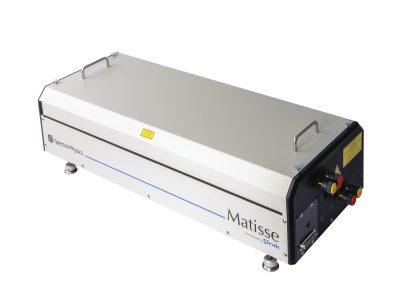
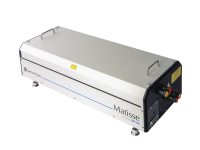
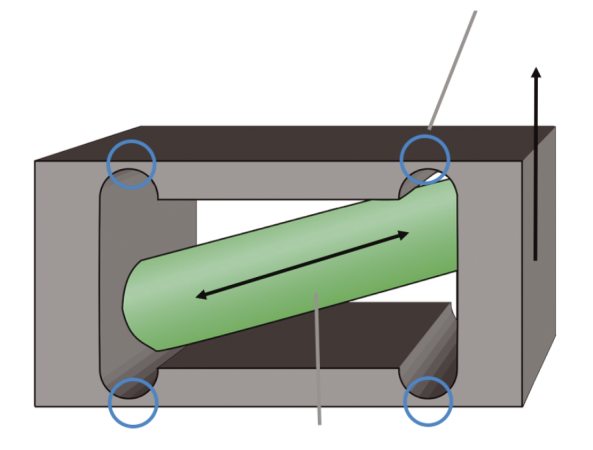
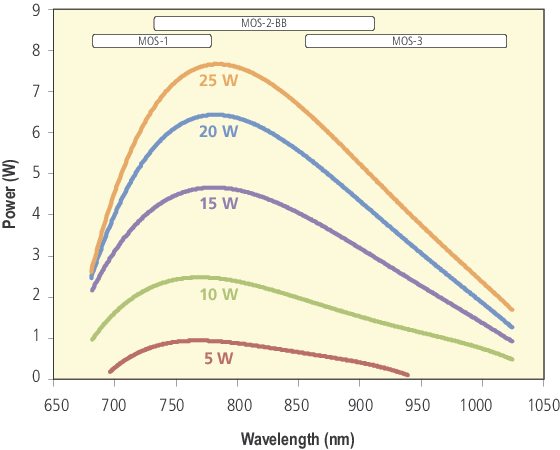
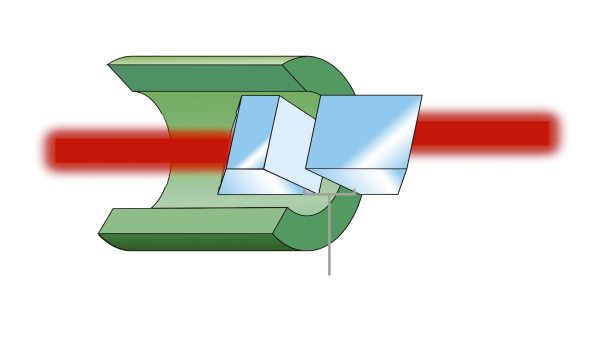
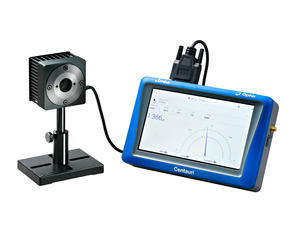
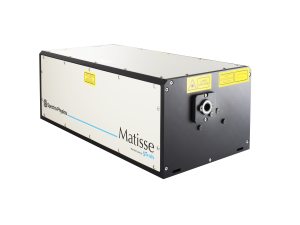
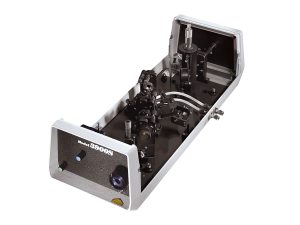
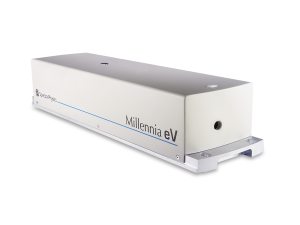
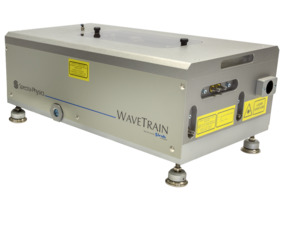
 Ultra-High Velocity
Ultra-High Velocity